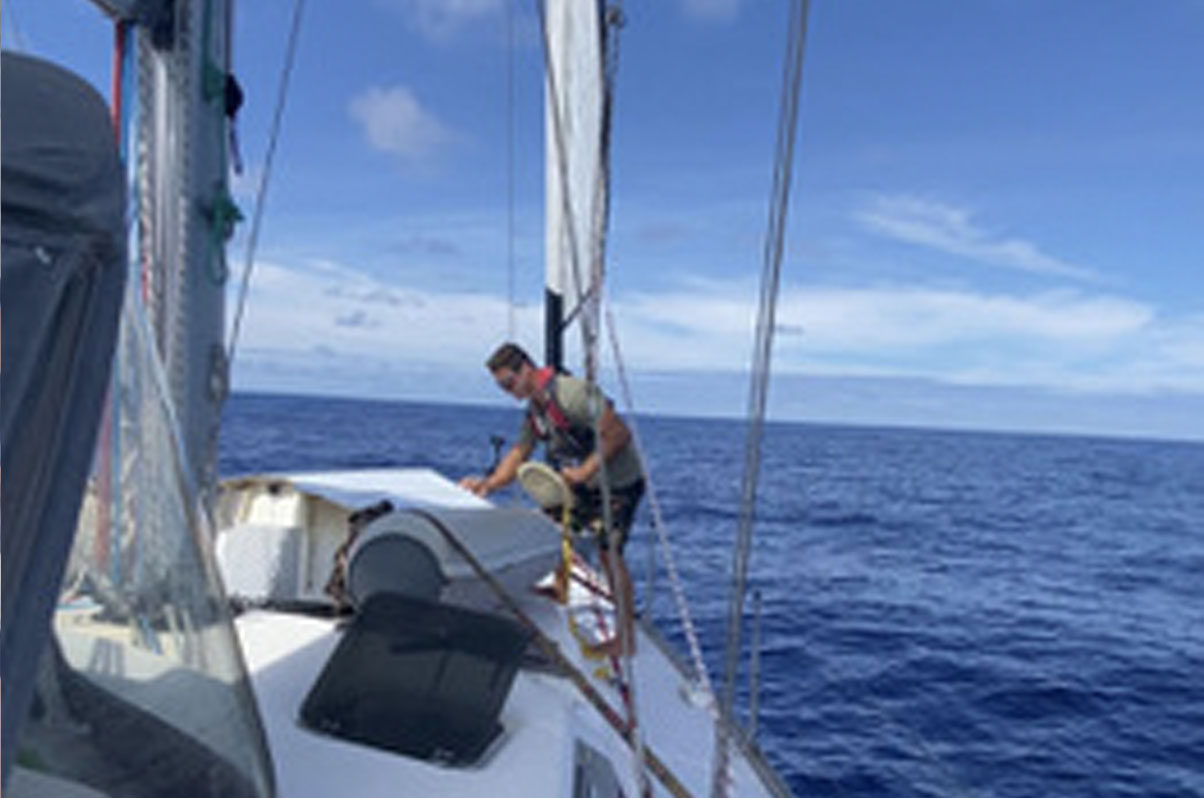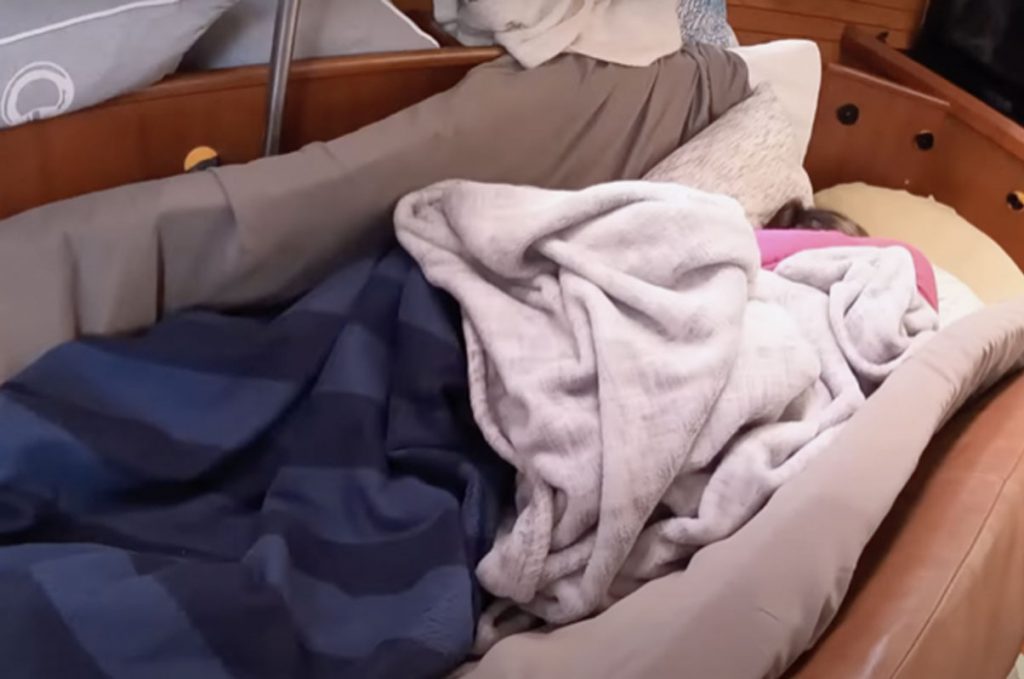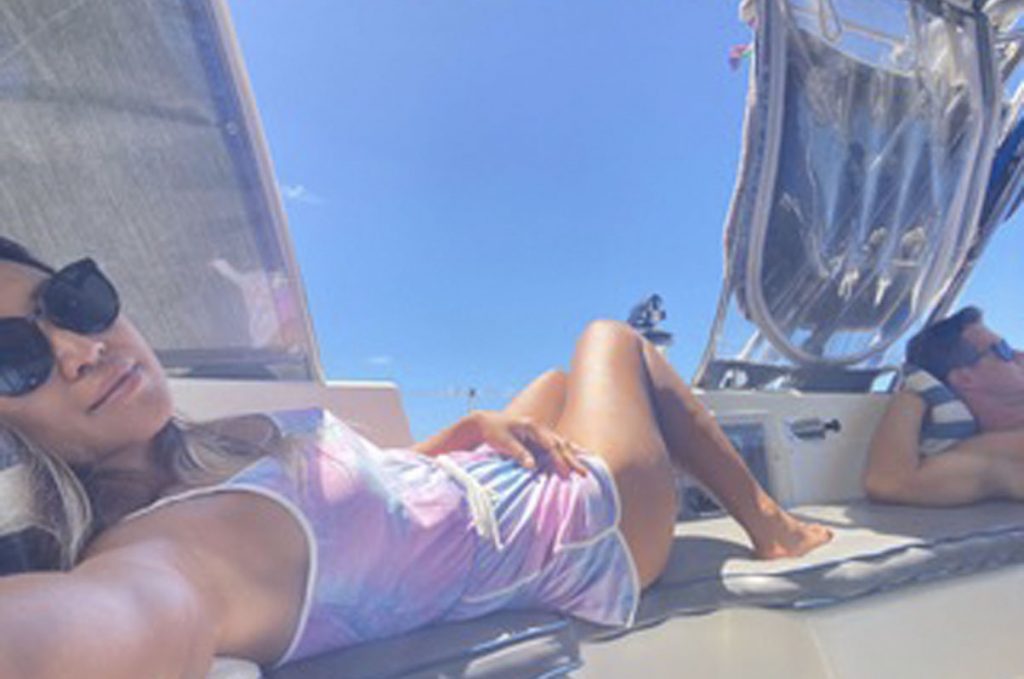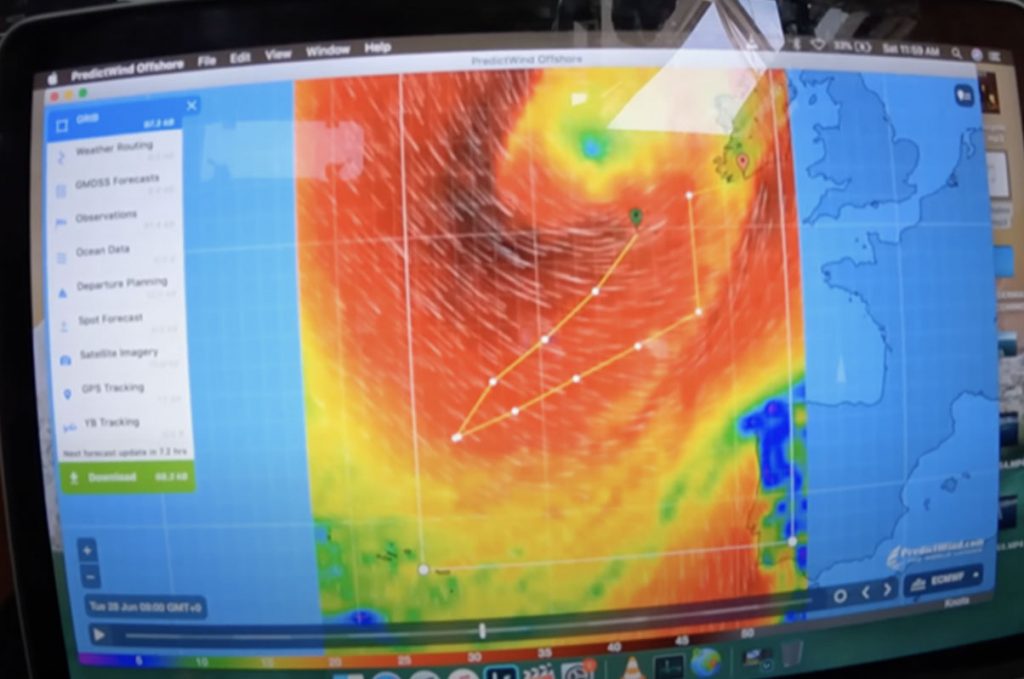
An Atlantic crossing in a small sailboat and minimal crew is something very special. Not only are you crossing an ocean but you are limited by the number of available hands on deck. Someone always needs to be manning the helm and with only two people, it can make life very interesting and puts who you truly are, to the test.

Sleep & Shifts
First, let’s first talk about sleep…or the lack thereof. This was a huge worry for us since we didn’t know what to expect. Crossing the ocean means sailing 24/7 without the ability to simply pull in somewhere to rest or duck out from weather. Knowing that we wouldn’t be able to sleep when the weather demanded our attention was an interesting concept to take in before before setting off. We know many people have crossed short-handed or even single-handed, so we knew it was possible. We just had to experience it for ourselves.
Steph and I did six hour shifts at the helm. For the first several days, it was very difficult to sleep while getting used to the motion and noises, which are far different than sleeping while at anchor. As several days passed, our sea legs and comfort levels started falling into place. If one of us needed extra sleep or just wanted to stay on watch longer, we could accommodate each other and that worked out great for the rest of the passage. The six hour shifts worked nicely as it allowed an hour or two for us to spend time together, whether it be one of us below deck or both of us in the cockpit together, we had the company and conversation. Having the extra time between shifts helped in instances where it could take up to three hours for us to fall asleep. No matter how deliriously tired we were, the tossing and turning from the motion of the boat made it hard to get rest. After several days, I learned that in order to quickly fall asleep, I had to put my earphones in, blast music and drown out any other noises. It took a good week or so to get used to the sleep schedule but eventually our internal clocks adjusted and life started to feel somewhat normal. The hardest time we had in finding sleep was when we were in 15-20 foot seas, in excess of 35 knot winds that lasted four and a half to five days. That’s when we started to get a bit foggy due to sleep deprivation but it was all part of the unforgettable experience.

Food
We knew it could take several days to get our sea legs so we pre-prepped dinners for two weeks. Pre-cooked bags of rice, cooked meat, pastas etc. Breakfasts and lunches were usually something easily put together like fruit, yogurt, oatmeal or cereal, if it was too rough to cook. Most of the time, one of us was always able to prepare a meal. Whether it was eggs or oatmeal for breakfast, frozen chicken strips that we’d pop into the oven, sandwiches or wraps. Wraps are ‘great’ since they seem to last forever. Steph and I do enjoy our snacks. Having a tasty treat here and there was always a good morale booster. We even brought Pepsi on board, enough for one per night. We never have pop or soda onboard, so it was a nice sugar kick on the late evening shifts. It gets more difficult once all the fresh produce is gone. We really started to crave fruit and veggies but frozen or canned helps as well, though not the same. Ten or so days in, life started to revolve around food. It was what we looked forward to each day. Once we were done eating one thing, we’d be thinking of what to have next. Knowing we are big snackers, we made sure to store lots of snacks onboard and to have a variety to choose from.

Keeping Busy
At times, keeping busy was difficult to do. Little exercise workouts here and there, cleaning the boat, adjusting sails, watching videos or reading can help. Personally, I can examine the water for hours. l enjoy finding wave patterns in efforts to make sailing conditions more comfortable and sourcing out currents to see which direction they’re heading. We could be less than a mile away from a current heading in a favourable direction. Following patterns in the waves, how the wind moves over top of the water, movement of seaweed, sea foam, debris and changes in water colour can all be clear indications of where the current is present. Sometimes, the slightest change in waves seen in the distance can help. I noticed that every four to six hours, the wave direction would change ever so slightly even in consistent wind directions.
What kept me quite busy was constantly adjusting the sails. I wanted to ensure the boat was as balanced as she could be at all times. This would allow the autopilot to work more efficiently and to consume less power. Reefed or not, I would adjust the sails, not only to be balanced but to prevent chaffing sheets and halyards.

Weather Routing
I wanted to be reliant on myself and no one else For this reason, we did not opt to hire a weather router. We know what conditions we like to sail in and what our boat can do from our personal experiences. Being in the middle of nowhere, I wouldn’t feel as confident nor comfortable following the suggestions made by someone who is sitting in a comfy office and not physically there with us. As long as we had he proper tools to get the information needed to create our own routes, I didn’t see any added safety in hiring a weather router and felt confident in our own decision making. All we carried onboard was an IridiumGo with a subscription to PredictWind Offshore. I would route once in the morning with the first 8:00AM report and make several routes for the following days based on our our speed and wind conditions. I would adjust them throughout the day to optimize the route with the conditions we were in. I’d do this until the next forecast update and re-route based on where we ended up. At times, just a few degrees east or west over a course of 24 hours would have a huge effect on the conditions we sailed in. I weather routed two to three days ahead of where I ideally wanted to end up in efforts to be sailing the best conditions possible. I’d never want to plan for the day of. One may think, it’s an ocean… just go with the wind! It doesn’t work like that. In some instances, we had to sail as tight to the wind as we could in a completely wrong direction just so we could meet make it to more optimal conditions in the following days. Note: Sailing from the West to the East in the Atlantic is considered to be more demanding as you’re faced with a lot of closed hauled sailing, so being on top of weather routing is very important. Apparently crossing from East to West is a much different story so I’ll be happy to share that when we make our way back to the Caribbean.
I’m going to end off here for this month’s read, but be sure to tune in next month when I share more about the unforgettable experiences from silly challenges, sights, smells, scares and just plain bazaar instances during our transatlantic.
If you can’t wait that long then head over to our Youtube channel to watch our Atlantic Crossing videos. We’ve got a playlist that details the entire crossing from Saint Martin to Ireland.
Travis – Sailing Jibsea
Youtube: www.youtube.com/sailingjibsea
Instagram: @sailingjibsea
Facebook: www.facebook.com/sailingjibsea
Patreon: www.patreon.com/jibsea
